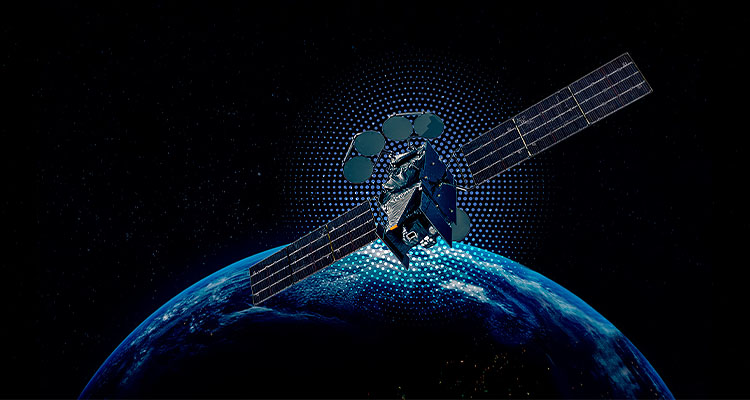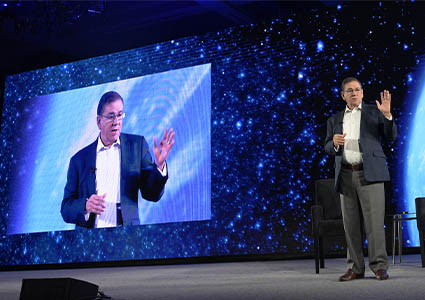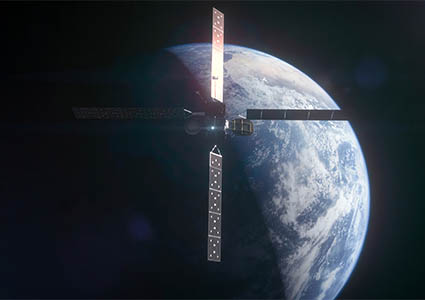
Through innovative collaboration, Intelsat is advancing its satellite telecommunications capabilities around the globe
In today’s digital-obsessed era, it’s easy to take connectivity for granted. When we pick up the phone and make a call from almost anywhere in the world, search for the latest news, or stream entertainment, we rarely pause to consider how we’re able to do so, let alone think of the companies making these actions possible.
Intelsat is a multinational satellite services provider considered to be the founding architects of the global satellite communications industry. With one of, if not the world’s largest and most trusted satellite and terrestrial networks, Intelsat delivers technology to power today’s high-performance digital connectivity and link people, businesses, and communities across the globe.

We’re joined by Intelsat’s CEO, David Wajsgras, to learn more about how the company is celebrating its 60th year in business and striving to maintain its competitive edge through strategic collaboration amid significant industry transformation. “Intelsat’s history begins with a concept: in the 1940s, science fiction author, Arthur C. Clarke, determined that the Earth’s globe could be covered with bandwidth signals using only three satellites if strategically positioned,” David begins. “Responding to this concept, a collective of exceptionally clever people, both from inside and outside of government organizations, set out to develop technology to make Arthur Clarke’s vision a reality.
“A consortium was established by the telecommunication agencies of 18 different countries, including the US under the leadership of the Kennedy Administration. The International Telecommunications Satellite Organization, or Intelsat, was created in 1964 to own and manage a constellation of communication satellites providing international broadcast services. However, after 37 years as an intergovernmental entity, we became a private company in 2001 and a series of investments in satellites and ground infrastructure followed.”
Connecting communities
Intelsat launched its first satellite, Early Bird 1, in 1965, just eight months after its foundation. “The launch of our first satellite sparked a chain of events that led to a multitude of new technologies and game changing innovations,” David explains. “For many years, we’ve operated in the geostationary Earth orbit (GEO), which is approximately 36,000 kilometers from Earth, and we fly more commercial GEO satellites than any other operator in the world.
“Today, we have roughly 60 satellites in GEO orbit at any given time in different orbital slots. In simple terms, these satellites beam bandwidth down to Earth to enable communications, bringing, for example, media to people’s homes through either direct-to-home capabilities or cable channels; enabling people to use Wi-Fi on airplanes or access the internet from some of the most remote areas on the globe; or even providing full-spectrum communication capabilities to private jets.
“Intelsat operates in almost every vertical in the US and we’ve expanded our portfolio to support the world’s critical industries,” he states. “We provide bandwidth to more than 50 countries, and from a satellite perspective, we’re one of the largest providers to the US Government and in regions like the continent of Africa. With an emphasis on connecting the unconnected, we also focus on bringing bandwidth capabilities to communities in very rural areas of the world.
“We fought through the rainy season in Madagascar, for example, to provide first-time broadband services to people in some of the most remote areas of the country. While we of course must protect our stakeholders’ interests, we take our social responsibility very seriously. When it comes to setting up networks and communication capabilities in geographic areas that are under social, political, or environmental stress, we believe we do so more frequently and more effectively than any other company in the world.
The next level
 “We’re investing in ground infrastructure across our network, especially in our teleports, where huge white concave dishes both transmit and receive signals from spacecraft. These teleports are connected to broader networks and are an important node in the global communications network. We must continue to invest in these strategic assets as well as new technologies to deliver communications even more efficiently and effectively.”
“We’re investing in ground infrastructure across our network, especially in our teleports, where huge white concave dishes both transmit and receive signals from spacecraft. These teleports are connected to broader networks and are an important node in the global communications network. We must continue to invest in these strategic assets as well as new technologies to deliver communications even more efficiently and effectively.”
Returning to the evolution of the space and communications industry at large, David suggests that the emergence of new companies like SpaceX and Amazon’s Project Kuiper have accelerated innovation. “Technology in our field has traditionally evolved at a moderate pace, but the last decade or so has seen a significant acceleration,” he recalls. “Recent developments have advanced capabilities to what we call high throughput satellites, which meaningfully increases the amount of bandwidth that can be uplinked and downlinked.”
Combined with growing demand for faster connectivity, new companies have capitalized on this opportunity and entered the industry with low Earth orbit (LEO) capabilities, operating in an orbit between 250-to-2000 kilometers from Earth. “Starlink, Elon Musk’s company, for instance, set out to compete with traditional satellite communications companies by building and launching LEO satellites,” David explains. “With the increase in the pace of play and the introduction of new technologies, we recognized that we couldn’t just ‘pedal faster’ to keep up – we needed to reevaluate our position from a market perspective.
“Our engineers and technology experts decided to take our operating model to the next level by investing in software defined satellites. Without getting too specific, the speed of connectivity and the security this will bring to the industry is unprecedented. While the catalyst for this move was increased competition, there was also an internal drive to continue being one of the world’s foremost leaders in the satellite communications industry.”
However, Intelsat’s strategy extends beyond altering the business model. Determined not to be outpaced by some of the fast-growing startups, the business recently executed a deal with SES, a Luxembourg-based satellite telecommunications network provider. SES is set to acquire Intelsat, and the two companies plan to merge operations post-closing.
Competitive position
“SES is similar to Intelsat from a size and capability perspective, and although SES is purchasing us, we’re collectively viewing the deal as a merger,” David elaborates. “We’re currently going through regulatory approvals and hope to close sometime in the second half of 2025. Intelsat already operates a large GEO portfolio, as does SES, but SES also owns and operates a medium Earth orbit (MEO) constellation. MEO is positioned between LEO and GEO, with unique capabilities to bring critical solutions to global customers.
“Prior to the SES deal being signed, we also partnered with Eutelsat OneWeb, the Paris-based satellite communications company. Eutelsat’s CEO, Eva Berneke, and I sat down and saw just how powerful it would be to structure a partnership that offers dual orbit capabilities (both GEO and LEO) to Intelsat’s customers around the world. It made a lot of sense for both our companies.
“The partnership with Eutelsat and proposed acquisition by SES, once closed, will help us level the playing field and maintain our competitive position in the marketplace. In the coming years, the combined company will have a portfolio of GEO, MEO, and LEO solutions, which is what we believe is necessary to compete with new space companies moving forward.”
David’s wealth of experience and proven track record of successful business turnaround efforts, combined with a collaborative and innovative approach to future growth has served the company well. “I came in to reinvigorate the technology roadmap and Intelsat team, and it’s satisfying to have navigated several challenges and get the company back to a world-leading position,” he reflects. “In recent months, it’s been exciting to collaborate with other companies in the industry as we prepare for an equally exciting future.
“We’re cautiously optimistic that the global regulatory processes will conclude successfully, and we will combine with SES in 2025,” David concludes. “It wouldn’t surprise me to see further M&A activity among traditional satellite operators as new LEO companies and other competitors continue to spring up around the globe. One thing is certain – there will be new technologies, new players, and new capabilities having a positive impact on the industry for decades to come.”